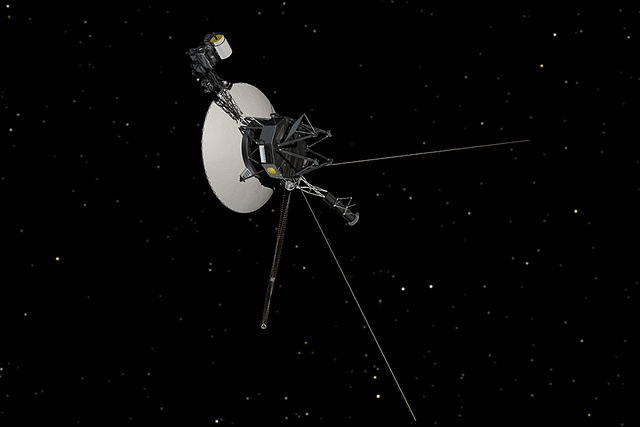Science
Voyager 2 Reconnected With Earth After NASA's Interstellar "Shout" Across Nearly 20 Billion Kilometres Works
- "So glad I can finally phone home."
- NASA has re-established full communications with Voyager 2.

This artist's concept shows NASA's Voyager spacecraft against a backdrop of stars. (Image: NASA/JPL-Caltech)
The National Aeronautics and Space Administration (NASA) successfully regained communication with Voyager 2 using a long-shot "shout" manoeuvre.
The spacecraft, which has been in operation for almost 46 years, had lost contact with Earth for about two weeks.
The spacecraft began transmitting science and telemetry data at 9.59 am Friday (4 August), India time. It was a confirmation for the US space agency that Voyager 2 is functioning normally and that it has stayed on its expected trajectory.
"So glad I can finally phone home," said the update from the Voyager mission's Twitter account.
On 21 July, a command sent to Voyager 2 unintentionally caused its antenna to shift 2 degrees away from Earth. As a result, the spacecraft was unable to receive commands from mission control or send data back to Earth.
Voyager 2 is currently located just under 20 billion kilometres away in interstellar space.
The mission team was able to detect Voyager 2's "heartbeat" or "carrier signal" just about a week ago. A carrier signal is what the spacecraft uses to send data back to Earth.
"The signal is too faint for data to be extracted, NASA said, "but the detection confirms that the spacecraft is still operating."
This brief contact was made possible through the use of the Deep Space Network (DSN), an array of large radio antennas that allows NASA to communicate with space missions.
Each of the three giant dishes is equidistant, ensuring continuous communication with different spacecraft as our planet rotates. These radio antennas are located in California (US), Madrid (Spain), and Canberra (Australia).
After catching the carrier signal, the team used the Canberra DSN station to send an interstellar "shout."
This shout is essentially an amplified radio signal that was directed towards Voyager 2, along with commands instructing the spacecraft to reorient its antenna towards Earth.
The odds weren't favourable, considering the massive distance between Earth and Voyager 2 and the unsuitable orientation of the antenna, but it worked!
The signal took approximately 18.5 hours to travel one way across the solar system to reach the spacecraft. In total, it took mission controllers 37 hours to confirm that the shout had indeed worked.
If the signal had not reached Voyager 2, NASA would have had to wait until mid-October to know what's up.
The spacecraft automatically adjusts its orientation multiple times a year to keep its antenna pointed towards our planet.
The next reset was slated to take place on 15 October.
Launched in 1977, Voyager 2 was sent to explore the outer planets, as well as to find and study the edge of the solar system.
"Voyager 1 and 2 were designed to take advantage of a rare planetary alignment to study the outer solar system up close," NASA says, with Voyager 2 targeting Jupiter, Saturn, Uranus and Neptune.
Voyager 2 eventually became the only spacecraft to study all four of the solar system's giant planets at close range.
In doing so, the spacecraft discovered moons at Jupiter, Uranus, and Neptune, and also new rings at the latter two planets.
In December 2018, Voyager 2 joined its twin, Voyager 1, to become the only human-made objects to enter interstellar space — the space between stars.
It is thought that data from at least some of the six instruments still in operation on Voyager 2 should be received until at least 2025.
There will come a time when there won't be enough electricity to power even one instrument. "Then," says NASA, "Voyager 2 will silently continue its eternal journey among the stars."
Voyager 1, at about 24 billion kilometres away the most distant spacecraft from Earth, is still in contact and doing fine.
The Voyager missions are a part of the NASA Heliophysics System Observatory.
Both probes are speeding through interstellar space at over 55,000 kilometres per hour, making them the only spacecraft to operate beyond the heliosphere.
How the story unfolded:
Support Swarajya's 50 Ground Reports Project & Sponsor A Story
Every general election Swarajya does a 50 ground reports project.
Aimed only at serious readers and those who appreciate the nuances of political undercurrents, the project provides a sense of India's electoral landscape. As you know, these reports are produced after considerable investment of travel, time and effort on the ground.
This time too we've kicked off the project in style and have covered over 30 constituencies already. If you're someone who appreciates such work and have enjoyed our coverage please consider sponsoring a ground report for just Rs 2999 to Rs 19,999 - it goes a long way in helping us produce more quality reportage.
You can also back this project by becoming a subscriber for as little as Rs 999 - so do click on this links and choose a plan that suits you and back us.
Click below to contribute.
Latest